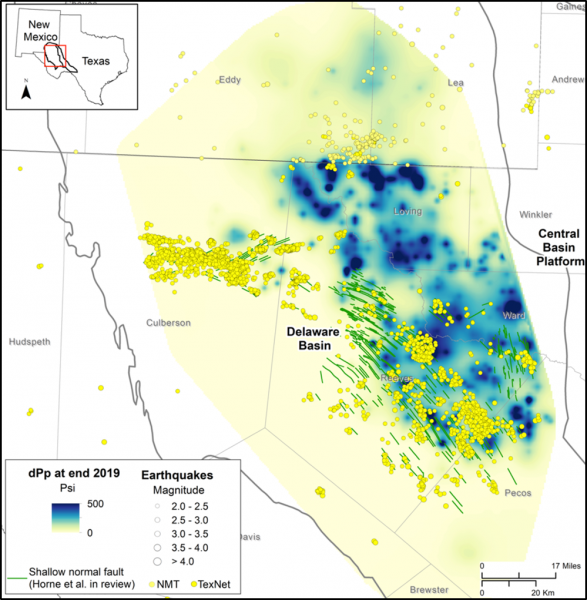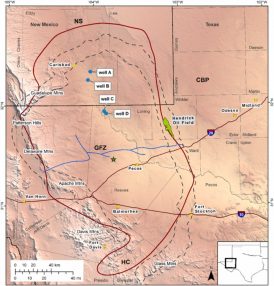New UT Model Explores Connection Between Pressure and Earthquakes in Far West Texas
May 24, 2022

A model created at The University of Texas at Austin is providing the most comprehensive look yet at subsurface pressure buildup associated with wastewater injection in the Delaware Mountain Group, a geologic formation that is the most commonly used layer for disposing of water brought up by oil and gas production in the Permian Basin.
To date, more than 11 billion barrels of wastewater have been injected into the formation. With all that water comes changes in subsurface pressure, which in some cases has been linked to increased seismicity. The study, the latest work by the UT Bureau of Economic Geology, could help to develop strategies to mitigate induced earthquakes and other issues related to injection, said Peter Hennings, the principal investigator at the Bureau’s Center for Integrated Seismicity Research (CISR).
Using the model, a research team at the Bureau tracked wastewater flow and associated pressure changes within the different geologic units of the Delaware Mountain Group over the past 36 years. The Delaware Mountain Group is the shallower of two geologic layers routinely used for injection.
The results were published recently in the Journal of Hydrology: Regional Studies.
According to Hennings, who is a co-author on the paper, insights from the flow model can help inform and improve wastewater injection practices in the region.
“The induced seismicity in the Delaware Basin is the most complex case that we’ve observed globally,” Hennings said. “It takes these types of input data sets for us to understand the geologic complexity and how to use these models to address different causal agents.”
The study builds on earlier work conducted by researchers at the UT Jackson School of Geosciences on the Delaware Mountain Group and nearby regions. These include work on wastewater injection, a study tracking the rise of regional seismicity, and a detailed geologic characterization of the formation based on 3D geologic modeling.
The study also incorporated data on when and how much wastewater was injected – data that’s collected by the Railroad Commission of Texas, the state agency that regulates the oil and gas industry. Most of the wastewater has been injected into the formation over the last decade. But the model starts in 1983 – the earliest year for which data is available – so it can capture fluid flow and pressure changes over time, said Bureau research scientist associate Jun Ge, who led the study.

“We are modeling the impact from the very beginning of record-keeping throughout the area of interest,” said Ge. “We include all of the details of water disposal activities in the area.”
According to the model, the increase in pore pressure in the formation can be significant, ranging from at least 100 – 400 pounds per square inch, with some areas potentially reaching up to 500 psi and higher near wastewater injection wells.
The model confirmed earlier research linking some earthquakes in the southern region of the Delaware Basin to wastewater injection. However, the connection between these quakes and wastewater injection is more complicated in the northern region of the basin, where seismic activity is increasing.
As wastewater injection into the formation is only expected to increase in the years ahead and then continue for decades, Hennings said that the model can help untangle the impacts of injection on seismicity, the integrity of thousands of old oil wells in the region and to the land surface itself.
“This work is so timely because it provides a basis for how we view the potential impact of injection and how these injection reservoirs can be managed as resources for disposal,” he said.
Aaron Velasco, a professor and earthquake expert at the University of Texas El Paso who was not involved with the research, said that the study adds to the Bureau’s track record of insightful research on seismicity in the Delaware Mountain Group.
“It’s probably one of the few agencies that has the sort of information that is critical for understanding how this particular set of geological formations are responding to production and to injection,” he said.
The study’s additional co-authors are the Bureau’s Katie Smye, J.P. Nicot, Seyyed Hosseini, Caroline Brenton and Rebecca Gao, who is also a doctoral student in the UT Department of Geological Sciences. Both the Bureau and the department are research units at the Jackson School of Geosciences. CISR funded the research.
For more information, contact: Anton Caputo, Jackson School of Geosciences, 512-232-9623; Monica Kortsha, Jackson School of Geosciences, 512-471-2241.
